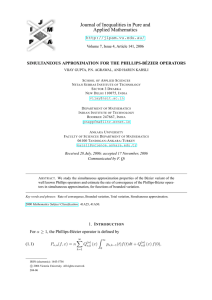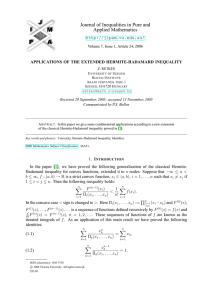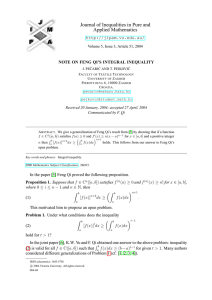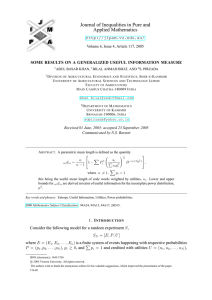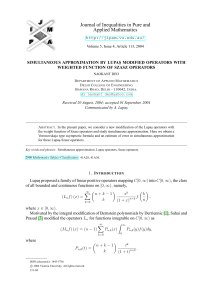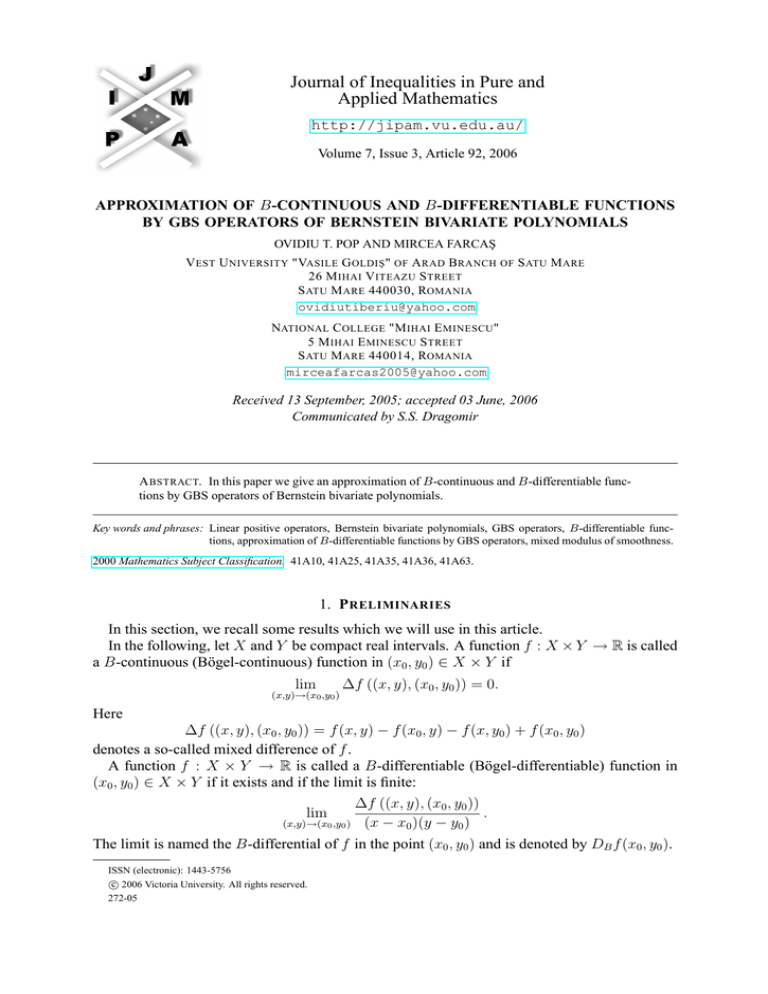
Journal of Inequalities in Pure and
Applied Mathematics
http://jipam.vu.edu.au/
Volume 7, Issue 3, Article 92, 2006
APPROXIMATION OF B-CONTINUOUS AND B-DIFFERENTIABLE FUNCTIONS
BY GBS OPERATORS OF BERNSTEIN BIVARIATE POLYNOMIALS
OVIDIU T. POP AND MIRCEA FARCAŞ
V EST U NIVERSITY "VASILE G OLDI Ş " OF A RAD B RANCH OF S ATU M ARE
26 M IHAI V ITEAZU S TREET
S ATU M ARE 440030, ROMANIA
ovidiutiberiu@yahoo.com
NATIONAL C OLLEGE "M IHAI E MINESCU "
5 M IHAI E MINESCU S TREET
S ATU M ARE 440014, ROMANIA
mirceafarcas2005@yahoo.com
Received 13 September, 2005; accepted 03 June, 2006
Communicated by S.S. Dragomir
A BSTRACT. In this paper we give an approximation of B-continuous and B-differentiable functions by GBS operators of Bernstein bivariate polynomials.
Key words and phrases: Linear positive operators, Bernstein bivariate polynomials, GBS operators, B-differentiable functions, approximation of B-differentiable functions by GBS operators, mixed modulus of smoothness.
2000 Mathematics Subject Classification. 41A10, 41A25, 41A35, 41A36, 41A63.
1. P RELIMINARIES
In this section, we recall some results which we will use in this article.
In the following, let X and Y be compact real intervals. A function f : X × Y → R is called
a B-continuous (Bögel-continuous) function in (x0 , y0 ) ∈ X × Y if
lim
(x,y)→(x0 ,y0 )
∆f ((x, y), (x0 , y0 )) = 0.
Here
∆f ((x, y), (x0 , y0 )) = f (x, y) − f (x0 , y) − f (x, y0 ) + f (x0 , y0 )
denotes a so-called mixed difference of f .
A function f : X × Y → R is called a B-differentiable (Bögel-differentiable) function in
(x0 , y0 ) ∈ X × Y if it exists and if the limit is finite:
∆f ((x, y), (x0 , y0 ))
.
lim
(x,y)→(x0 ,y0 ) (x − x0 )(y − y0 )
The limit is named the B-differential of f in the point (x0 , y0 ) and is denoted by DB f (x0 , y0 ).
ISSN (electronic): 1443-5756
c 2006 Victoria University. All rights reserved.
272-05
2
OVIDIU T. P OP AND M IRCEA FARCA Ş
The definitions of B-continuity and B-differentiability were introduced by K. Bögel in the
papers [5] and [6].
The function f : X × Y → R is B-bounded on X × Y if there exists K > 0 such that
|∆f ((x, y), (s, t))| ≤ K
for any (x, y), (s, t) ∈ X × Y .
We shall use the function sets B(X × Y) = f : X × Y → R|f bounded on X ×Y with
the usual sup-norm k · k∞ , Bb (X × Y ) = f : X × Y → R|f B-bounded on X × Y and we
set kf kB =
sup
|∆f ((x, y), (s, t)) |, where
(x,y),(s,t)∈X×Y
Cb (X × Y ) = f : X × Y → R|f B − continuous on X × Y ,
and Db (X × Y ) = f : X × Y → R|f B − differentiable on X × Y .
f ∈ Bb (X × Y ),
Let f ∈ Bb (X × Y ). The function ωmixed (f ; · , ·) : [0, ∞) × [0, ∞) → R, defined by
(1.1)
ωmixed (f ; δ1 , δ2 ) = sup {|∆f ((x, y), (s, t))| : |x − s| ≤ δ1 , |y − t| ≤ δ2 }
for any (δ1 , δ2 ) ∈ [0, ∞) × [0, ∞) is called the mixed modulus of smoothness.
For related topics, see [1], [2], [3] and [10].
Let L : Cb (X × Y ) → B(X × Y ) be a linear positive operator. The operator U L : Cb (X ×
Y ) → B(X × Y ) defined for any function f ∈ Cb (X × Y ) and any (x, y) ∈ X × Y by
(1.2)
(U Lf )(x, y) = (L(f (·, y) + f (x, ∗) − f (·, ∗))) (x, y)
is called the GBS operator ("Generalized Boolean Sum" operator) associated to the operator L,
where "·" and "∗" stand for the first and second variable.
Let the functions eij : X × Y → R, (eij )(x, y) = xi y j for any (x, y) ∈ X × Y , where
i, j ∈ N. The following theorem is proved in [1].
Theorem 1.1. Let L : Cb (X × Y ) → B(X × Y ) be a linear positive operator and U L :
Cb (X × Y ) → B(X × Y ) the associated GBS operator. Then for any f ∈ Cb (X × Y ), any
(x, y) ∈ (X × Y ) and any δ1 , δ2 > 0, we have
(1.3)
|f (x, y) − (U Lf )(x, y)| ≤ |f (x, y)| |1 − (Le00 )(x, y)|
p
p
+ (Le00 )(x, y) + δ1−1 (L(· − x)2 ) (x, y) + δ2−1 (L(∗ − y)2 ) (x, y)
p
−1 −1
2
2
(L(· − x) (∗ − y) ) (x, y) ωmixed (f ; δ1 , δ2 ).
+ δ1 δ2
In the following, we need the following theorem for estimating the rate of the convergence
of the B-differentiable functions (see [11]).
Theorem 1.2. Let L : Cb (X × Y ) → B(X × Y ) be a linear positive operator and U L :
Cb (X × Y ) → B(X × Y ) the associated GBS operator. Then for any f ∈ Db (X × Y ) with
J. Inequal. Pure and Appl. Math., 7(3) Art. 92, 2006
http://jipam.vu.edu.au/
B-C ONTINUOUS AND B-D IFFERENTIABLE F UNCTIONS
3
DB f ∈ B(X × Y ), any (x, y) ∈ X × Y and any δ1 , δ2 > 0, we have
(1.4)
|f (x, y) − (U Lf )(x, y)|
p
≤ |f (x, y)||1−(Le00 )(x, y)|+3kDB f k∞ (L(· − x)2 (∗ − y)2 ) (x, y)
p
p
+
(L(· − x)2 (∗ − y)2 )(x, y) + δ1−1 (L(· − x)4 (∗ − y)2 )(x, y)
p
+ δ2−1 (L(· − x)2 (∗ − y)4 )(x, y)
−1 −1
2
2
+ δ1 δ2 L(· − x) (∗ − y) (x, y) ωmixed (DB f ; δ1 , δ2 ).
2. M AIN R ESULTS
Let the sets ∆2 = {(x, y) ∈ R × R|x, y ≥ 0, x + y ≤ 1} and F(∆2 ) = {f |f : ∆2 → R}.
For m a non zero natural number, let the operators Bm : F(∆2 ) → F(∆2 ), defined for any
function f ∈ F(∆2 ) by
X
k j
(2.1)
(Bm f )(x, y) =
pm,k,j (x, y)f
,
m m
k,j=0
k+j≤m
for any (x, y) ∈ ∆2 , where
(2.2)
pm,k,j (x, y) =
m!
xk y j (1 − x − y)m−k−j .
k!j!(m − k − j)!
The operators are named Bernstein bivariate polynomials (see [8]).
Lemma 2.1. The operators (Bm )m≥1 are linear and positive on F(∆2 ).
Proof. The proof follows immediately.
For m a non zero natural number, let the GBS operator of Bernstein bivariate polynomials
U Bm (see [1]), U Bm : Cb (∆2 ) → B(∆2 ) defined for any function f ∈ Cb (∆2 ) and any
(x, y) ∈ ∆2 by
(2.3)
(U Bm f )(x, y) = (Bm (f (x, ∗) + f (· , y) − f (· , ∗))) (x, y)
X
j
k
k j
=
pm,k,j (x, y) f x,
+f
,y − f
,
.
m
m
m m
k,j=0
k+j≤m
Lemma 2.2. The operators (Bm )m≥1 verify for any (x, y) ∈ ∆2 the following:
(2.4)
(2.5)
(2.6)
(2.7)
(Bm e00 )(x, y) = 1;
x(1 − x)
Bm (· − x)2 (x, y) =
;
m
y(1 − y)
Bm (∗ − y)2 (x, y) =
;
m
3(m − 2) 2 2 m − 2 2
m−1
Bm (· − x)2 (∗ − y)2 (x, y) =
xy −
(x y + xy 2 ) +
xy;
3
3
m
m
m3
J. Inequal. Pure and Appl. Math., 7(3) Art. 92, 2006
http://jipam.vu.edu.au/
4
OVIDIU T. P OP AND M IRCEA FARCA Ş
Bm (· − x)4 (∗ − y)2 (x, y)
(2.8)
5(3m2 − 26m + 24) 4 2 6(3m2 − 26m + 24) 3 2 6(m2 − 7m + 6) 3
xy +
xy −
xy
m5
m5
m5
3m2 − 17m + 14 2
3m2 − 41m + 42 2 2 3m2 − 26m + 24 4
−
x
y
+
x
y
+
xy
m5
m5
m5
m−2 2 m−1
−
xy +
xy
m5
m5
=−
and
(2.9)
Bm (· − x)2 (∗ − y)4 (x, y)
5(m2 − 26m + 24) 2 4 6(3m2 − 26m + 24) 2 3 6(m2 − 7m + 6) 3
xy +
xy −
xy
m5
m5
m5
3m2 − 41m + 42 2 2 3m2 − 26m + 24 4 3m2 − 17m + 14 2
−
xy +
xy +
xy
m5
m5
m5
m−2 2
m−1
−
x y+
xy
5
m
m5
for any non zero natural number m.
=−
Proof. Let (x, y) ∈ ∆2 and m be a non zero natural number. We have
X
m!
(Bm e00 )(x, y) =
xk y j (1 − x − y)m−k−j
k!j!(m
−
k
−
j)!
k,j=0
k+j≤m
= (x + y + 1 − x − y)m = 1,
so (2.4) holds,
(Bm e10 )(x, y) =
X
k,j=0
k+j≤m
k
m!
xk y j (1 − x − y)m−k−j
k!j!(m − k − j)!
m
X
=x
k=1,j=0
k+j≤m
(m − 1)!
xk−1 y j (1 − x − y)m−k−j
(k − 1)!j!(m − k − j)!
= x,
it results that
(Bm e10 )(x, y) = x
(2.10)
and similarly
(Bm e01 )(x, y) = y.
(2.11)
In the same way, using the formulas
k 2 = k(k − 1) + k,
k 3 = k(k − 1)(k − 2) + 3k(k − 1) + k,
k 4 = k(k − 1)(k − 2)(k − 3) + 6k(k − 1)(k − 2) + 7k(k − 1) + k,
we obtain
(2.12)
(2.13)
m−1 2
1
x + x,
m
m
(m − 1)(m − 2) 3 3(m − 1) 2
1
(Bm e30 )(x, y) =
x +
x + 2 x,
2
2
m
m
m
(Bm e20 )(x, y) =
J. Inequal. Pure and Appl. Math., 7(3) Art. 92, 2006
http://jipam.vu.edu.au/
B-C ONTINUOUS AND B-D IFFERENTIABLE F UNCTIONS
5
(m − 1)(m − 2)(m − 3) 4
x
m3
1
6(m − 1)(m − 2) 3 7(m − 1) 2
+
x
+
x
+
x
m3
m3
m3
and similarly the relations (Bm e02 )(x, y), (Bm e03 )(x, y), (Bm e04 )(x, y).
We have
X
(m − 1)!
k
m−1
(Bm e11 )(x, y) =
y
xk y j−1 (1 − x − y)m−k−j
m
k!(j − 1)!(m − k − j)!
m−1
k=0,j=1
(2.14) (Bm e40 )(x, y) =
k+j≤m
=
m−1
y(Bm−1 e10 )(x, y),
m
(Bm e21 )(x, y)
2 X
2
m−1
(m−1)!
k
k j−1
m−k−j
=
y
x y (1−x−y)
m
k!(j
−1)!(m−k−j)!
m−1
k=0,j=1
k+j≤m
=
m−1
m
2
y(Bm−1 e20 )(x, y),
and in the same way, we write (Bm e31 )(x, y), (Bm e41 )(x, y), (Bm e32 )(x, y), (Bm e42 )(x, y).
Taking (2.12) - (2.14) into account, we obtain
m−1
(Bm e11 )(x, y) =
(2.15)
xy,
m
(m − 1)(m − 2) 2
m−1
(2.16)
(Bm e21 )(x, y) =
x y+
xy,
2
m
m2
(2.17)
(Bm e31 )(x, y) =
(m − 1)(m − 2)(m − 3) 3
xy
m3
3(m − 1)(m − 2) 2
m−1
+
x y+
xy,
3
m
m3
(m − 1)(m − 2)(m − 3)(m − 4) 4
xy
m4
6(m − 1)(m − 2)(m − 3) 3
7(m − 1)(m − 2) 2
m−1
+
x y+
x y+
xy,
4
4
m
m
m4
(2.18) (Bm e41 )(x, y) =
(2.19) (Bm e22 )(x, y) =
(m − 1)(m − 2)(m − 3) 2 2
xy
m3
(m − 1)(m − 2) 2
m−1
+
(x y + xy 2 ) +
xy,
3
m
m3
(m − 1)(m − 2)(m − 3)(m − 4) 3 2
xy
m4
(m − 1)(m − 2)(m − 3) 3
3(m − 1)(m − 2)(m − 3) 2 2
+
x y+
xy
4
m
m4
3(m − 1)(m − 2) 2
(m − 1)(m − 2) 2 m − 1
+
x y+
xy +
xy,
4
m
m4
m4
(2.20) (Bm e32 )(x, y) =
J. Inequal. Pure and Appl. Math., 7(3) Art. 92, 2006
http://jipam.vu.edu.au/
6
OVIDIU T. P OP AND M IRCEA FARCA Ş
(m − 1)(m − 2)(m − 3)(m − 4)(m − 5) 4 2
xy
m5
(m − 1)(m − 2)(m − 3)(m − 4) 4
+
xy
m5
6(m − 1)(m − 2)(m − 3)(m − 4) 3 2
xy
+
m5
6(m − 1)(m − 2)(m − 3) 3
+
xy
m5
7(m − 1)(m − 2)(m − 3) 2 2
+
xy
m5
7(m−1)(m−2) 2
(m−1)(m−2) 2 m−1
+
x y+
xy +
xy
5
m
m5
m5
and similarly the relations (Bm e12 )(x, y), (Bm e13 )(x, y), (Bm e14 )(x, y), (Bm e23 )(x, y),
(Bm e24 )(x, y).
Now, we have
(2.21)
(Bm e42 )(x, y) =
(Bm (· − x)2 )(x, y) = (Bm e20 )(x, y) − 2x(Bm e10 )(x, y) + x2 (Bm e02 )(x, y),
(Bm (· − x)2 (∗ − y)2 )(x, y) = (Bm e22 )(x, y) − 2y(Bm e21 )(x, y) + y 2 (Bm e20 )(x, y)
− 2x(Bm e12 )(x, y) + 4xy(Bm e11 )(x, y) − 2xy 2 (Bm e10 )(x, y)
+ x2 (Bm e02 )(x, y) − 2x2 y(Bm e01 )(x, y) + x2 y 2 (Bm e00 )(x, y),
(Bm (· − x)4 (∗ − y)2 )(x, y)
= (Bm e40 )(x, y) − 2y(Bm e41 )(x, y) + y 2 (Bm e40 )(x, y)
− 4x(Bm e32 )(x, y) + 8xy(Bm e31 )(x, y) − 4xy 2 (Bm e30 )(x, y)
+ 6x2 (Bm e22 )(x, y) − 12x2 y(Bm e21 )(x, y) + 6x2 y 2 (Bm e20 )(x, y)
− 4x3 (Bm e12 )(x, y) + 8x3 y(Bm e11 )(x, y) − 4x3 y 2 (Bm e10 )(x, y)
+ x4 (Bm e02 )(x, y) − 2x4 y(Bm e01 )(x, y) + x4 y 2 (Bm e00 )(x, y)
and taking (2.9) – (2.21) into account, we obtain (2.5), (2.7) and (2.8). Similarly we obtain
(2.9).
Lemma 2.3. The operators (Bm )m≥1 verify for any (x, y) ∈ ∆2 the following inequalities:
1
(2.22)
(Bm (· − x)2 )(x, y) ≤
,
4m
1
(2.23)
(Bm (∗ − y)2 )(x, y) ≤
,
4m
for any non zero natural number m,
9
(2.24)
Bm (· − x)2 (∗ − y)2 (x, y) ≤
,
4m2
for any natural number m, m ≥ 2,
9
Bm (· − x)4 (∗ − y)2 (x, y) ≤ 3 ,
(2.25)
m
9
(2.26)
Bm (· − x)2 (∗ − y)4 (x, y) ≤ 3 ,
m
for any natural number m, m ≥ 8.
J. Inequal. Pure and Appl. Math., 7(3) Art. 92, 2006
http://jipam.vu.edu.au/
B-C ONTINUOUS AND B-D IFFERENTIABLE F UNCTIONS
Proof. Because x(1 − x) ≤
From (2.7), we have
1
4
7
for any x ∈ [0, 1], (2.22) and (2.23) results.
2(m − 2) 2 2 m − 2
1
Bm (· − x)2 (∗ − y)2 (x, y) =
xy +
x(1 − x)y(1 − y) + 3 xy
3
3
m
m
m
1
2(m − 2) m − 2
≤
+
+ 3
m3
16m3
m
33m − 50
=
,
16m3
from where (2.24) results.
From (2.8), we have
Bm (· − x)4 (∗ − y)2 (x, y)
6(3m2 − 26m + 24) 3 2
3m2 − 26m + 24 4
x y (1 − x) +
x y(y + 1)
=
m5
m5
3m2 − 17m + 14 2
6(m2 − 7m + 6) 3
−
x
y
+
x y(1 − y)
m5
m5
24m − 28 2 2 m − 2
+
xy +
xy(1 − y) + xy.
m5
m5
But
3m2 − 26m + 24 4
3m2 − 26m + 24 2
x
y(y
+
1)
≤
2
xy
m5
m5
10m − 12 2
6m2 − 42m + 36 2
x y−
xy
=
5
m
m5
10m − 12 3 2
6m2 − 42m + 36 2
≤
x y−
xy
5
m
m5
and then, from the inequalities above, we obtain
(2.27) Bm (· − x)4 (∗ − y)2 (x, y)
≤
6(3m2 − 26m + 24) 3 2
6m2 − 42m + 36 2
x
y
(1
−
x)
+
x y(1 − y)
m5
m5
3m2 − 17m + 14 2
10m − 12 2 2
+
x y(1 − y) +
x y (1 − y)
5
m
m5
14m − 16 2 2 m − 2
+
xy +
xy(1 − y) + xy.
m5
m5
Because x(1 − x) ≤ 14 , y(1 − y) ≤ 41 , xy ≤ 1 for any x, y ∈ [0, 1], from (2.27) we have
Bm (· − x)4 (∗ − y)2 (x, y)
6(3m2 − 26m + 24) 6m2 − 42m + 36
≤
+
4m5
4m5
2
3m − 17m + 14 10m − 12 14m − 16 m − 2
+
+
+
+
+1
4m5
4m5
m5
4m5
27m2 − 148m + 170
=
,
m5
from where (2.25) results.
J. Inequal. Pure and Appl. Math., 7(3) Art. 92, 2006
http://jipam.vu.edu.au/
8
OVIDIU T. P OP AND M IRCEA FARCA Ş
Theorem 2.4. Let the function f ∈ Cb (∆2 ). Then, for any (x, y) ∈ ∆2 , any natural number m,
m ≥ 2, we have
|f (x, y) − (U Bm f )(x, y)|
−1 1
−1 1
−1 −1 3
≤ 1 + δ1 √ + δ2 √ + δ1 δ2
ωmixed (f ; δ1 , δ2 )
2m
2 m
2 m
for any δ1 , δ2 > 0 and
7
1
1
.
(2.29)
|f (x, y) − (U Bm f )(x, y)| ≤ ωmixed f ; √ , √
2
m
m
(2.28)
Proof. For the first inequality we apply Theorem 1.1 and Lemma 2.3. The inequality (2.29) is
obtained from (2.28) by choosing δ1 = δ2 = √1m .
Corollary 2.5. If f ∈ Cb (∆2 ), then
(2.30)
lim (U Bm f )(x, y) = f (x, y)
m→∞
uniformly on ∆2 .
Proof. Because
f ∈ Cb(∆2 ), there results that f is uniform B-continuous on ∆2 and then
lim ωmixed f ; √1m , √1m = 0 (see [2] or [3]). From (2.29), there results the conclusion.
m→∞
Theorem 2.6. Let the function f ∈ Db (∆2 ) with DB f ∈ B(∆2 ). Then for any (x, y) ∈ ∆2 ,
any natural number m, m ≥ 8, we have
9
(2.31) |f (x, y) − (U Bm f )(x, y)| ≤
kDb f k∞
2m
3
3
3
−1
−1
−1 −1 9
√ +δ
√ +δ δ
+
+δ
ωmixed (DB f ; δ1 , δ2 )
2m 1 m m 2 m m 1 2 4m2
for any δ1 , δ2 > 0 and
3
1
1
(2.32)
|f (x, y) − (U Bm f )(x, y)| ≤
6kDB f k∞ + 13ωmixed DB f ; √ √
.
4m
m m
Proof. It results from Theorem 1.2 and Lemma 2.3.
R EFERENCES
[1] C. BADEA AND C. COTTIN, Korovkin-type theorems for generalised boolean sum operators, Colloquia Mathematica Societatis János Bolyai, 58, Approximation Theory, Kecskemét (Hunagary),
1990, 51–67.
[2] C. BADEA, Modul de continuitate în sens Bögel şi unele aplicaţii în aproximarea printr-un operator
Bernstein, Studia Univ. "Babeş-Bolyai", Ser. Math.-Mech., 18(2) (1973), 69–78 (Romanian).
[3] C. BADEA, I. BADEA, C. COTTIN AND H.H. GONSKA, Notes on the degree of approximation
of B-continuous and B-differentiable functions, J. Approx. Theory Appl., 4 (1988), 95–108.
[4] D. BĂRBOSU, Aproximarea funcţiilor de mai multe variabile prin sume booleene de operatori
liniari de tip interpolator, Ed. Risoprint, Cluj-Napoca, 2002 (Romanian).
[5] K. BÖGEL, Mehrdimensionale Differentiation von Funtionen mehrerer Veränderlicher, J. Reine
Angew. Math., 170 (1934), 197–217.
[6] K. BÖGEL, Über die mehrdimensionale differentiation, integration und beschränkte variation, J.
Reine Angew. Math., 173 (1935), 5–29.
J. Inequal. Pure and Appl. Math., 7(3) Art. 92, 2006
http://jipam.vu.edu.au/
B-C ONTINUOUS AND B-D IFFERENTIABLE F UNCTIONS
9
[7] K. BÖGEL, Über die mehrdimensionale differentiation, Jber. DMV, 65 (1962), 45–71.
[8] G.G. LORENTZ, Bernstein Polynomials, University of Toronto Press, Toronto, 1953.
[9] M. NICOLESCU, Contribuţii la o analiză de tip hiperbolic a planului, St. Cerc. Mat., III, 1-2, 1952,
7–51 (Romanian).
[10] M. NICOLESCU, Analiză Matematică, II, E. D. P. Bucureşti, 1980 (Romanian).
[11] O.T. POP, Approximation of B-differentiable functions by GBS operators (to appear in Anal. Univ.
Oradea).
[12] D.D. STANCU, Gh. COMAN, O. AGRATINI AND R. TRÎMBIŢAŞ, Analiză Numerică şi Teoria
Aproximării, I, Presa Universitară Clujeană, Cluj-Napoca, 2001 (Romanian).
J. Inequal. Pure and Appl. Math., 7(3) Art. 92, 2006
http://jipam.vu.edu.au/

